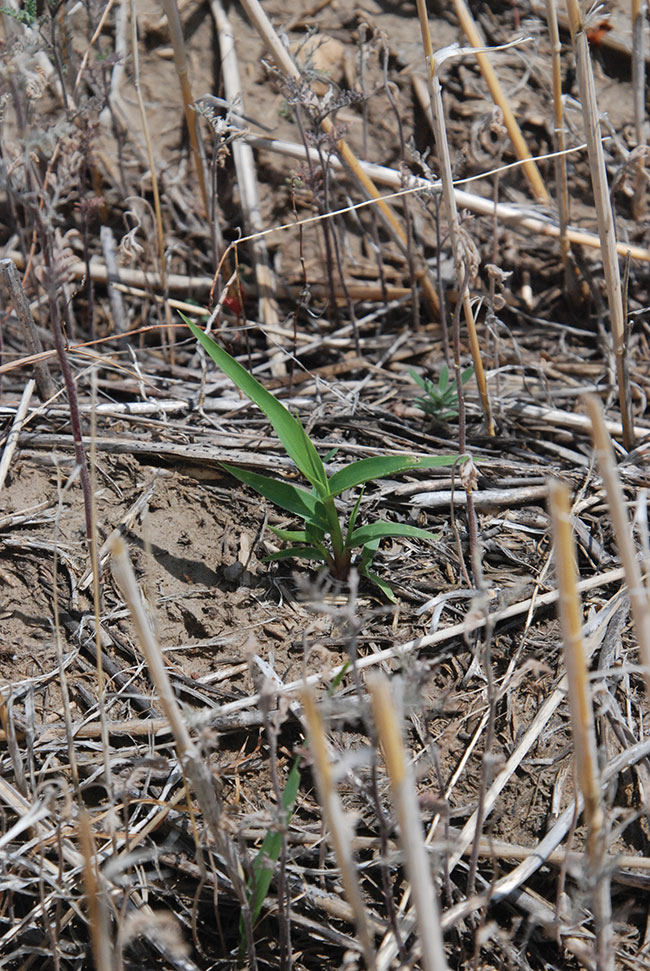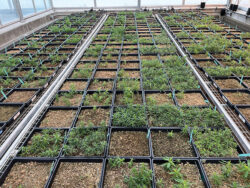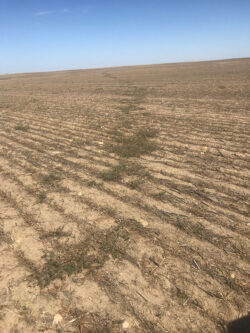
Features
Weeds
Spotlight on weeds
Weed surveys track changes in weed species abundance and resistance.
April 20, 2023 By Bruce Barker
 Green foxtail has retained its crown in all five surveys conducted since 1976.
Photo by Bruce Barker.
Green foxtail has retained its crown in all five surveys conducted since 1976.
Photo by Bruce Barker. Provincial weed surveys led by Agriculture and Agri-Food Canada (AAFC) have been conducted on the Prairies following the same methodology since the mid 1970s. The purpose is to track changes in weed populations over time, and more recently, to track the development of herbicide resistant weeds. In Saskatchewan, the most recent weed survey of weed abundance took place in 2019 and 2021, and the survey of herbicide-resistant weeds in 2019 and 2020.
“Canada is in third place with about 80 unique resistant biotypes behind the United States and Australia. And globally we’ve only seen one new herbicide mode of action developed in the last 30 years, so it is important to track shifts in weed populations and the development of herbicide resistant weeds,” says weed research scientist Charles Geddes at AAFC Lethbridge, Alta., who presented the findings of these two Saskatchewan surveys at the Saskatchewan Agronomy Update in December 2022.
Research scientist Julia Leeson and research assistant Shane Hladun at AAFC led the Saskatchewan survey of weed abundance, and compared these results with past weed surveys. A total of 2,277 fields of canola, spring wheat, barley, lentil, durum, oat, field pea, flax, chickpea, mustard and soybean were surveyed in late summer. Weeds were ranked according to their relative abundance based on frequency of occurrence, field uniformity and density in the fields surveyed.
Coming in at number one was green foxtail. It has retained this position in all five surveys conducted since 1976. Rounding out the top 10 are volunteer canola, wild oats, wild buckwheat, lamb’s-quarters, kochia, spiny annual sow-thistle, Canada thistle, volunteer wheat and stinkweed.
Volunteer canola has progressively moved up since 1976 when it ranked 25th, to the point where it has displaced wild oats and wild buckwheat into third and fourth place. Weeds that have increased the most since the 1970s include black medick, low cudweed, spiny annual sow-thistle, volunteer lentils, false cleavers, round-leaved mallow, northern willowherb, volunteer canola, barnyard grass species, broad-leaved plantain, foxtail barley, volunteer wheat and kochia.
A steady increase in herbicide resistant weeds
The Saskatchewan survey of herbicide resistant weeds was led by Geddes, and the survey included 419 fields of the overall 2,277 fields surveyed in Leeson’s survey. In these fields, weed patches were mapped during the survey, the seed was harvested, and taken to the lab for assessment for herbicide resistance. Overall, 1,651 weed seed samples were collected including 44 different species.

In Alberta, 78 per cent of kochia tested were resistant to Group 9 glyphosate.
Photo by Charles Geddes.
Group 1 resistant wild oat was found in 77 per cent of the 250 fields tested for wild oat herbicide resistance. This resistance has been on a steady, linear increase from around 10 per cent in 2003, jumping to around 30 per cent in 2009 and almost 60 per cent in 2015.
Group 2 resistant wild oat was found on 30 per cent of fields tested, which was similar to the last survey in 2015. Group 1 + 2 resistant wild oats was found in 26 per cent of fields tested, again similar to 2015.
“The issue is that if multiple resistance in wild oat develops to all Group 1 and 2 active ingredients, there is essentially no post-emergent option for the majority of field crops, except for herbicide tolerant canola,” says Geddes.
Group 1 resistant green foxtail is also on a steady, although slower increase, found on 28 per cent of 100 fields tested. Group 1 resistant yellow foxtail was found in all three fields in southeast Saskatchewan. But overall, yellow foxtail was found in less than one per cent of all fields surveyed.
Kochia patches were found in 164 fields, with 108 of those patches producing viable seed for testing. All 108 populations were confirmed to be Group 2 resistant – not surprisingly as all kochia has been assumed to be resistant to ALS inhibitors for quite some time.
Seventeen per cent of the 98 fields where sow-thistle was tested were found to be Group 2 resistant. Group 2 resistant sow-thistle had not been identified in previous Saskatchewan surveys, but has been present in Alberta for quite some time.
Red root pigweed populations resistant to Group 2 herbicides jumped to 57 per cent of fields tested, up from low levels in previous years. “This is an issue that is growing, but red root pigweed seed was only found in 27 of the 419 fields surveyed,” says Geddes.
False cleavers, a species that is on the rise in relative abundance in Saskatchewan, is also showing an increase in Group 2 resistance, 42 per cent of fields tested having resistance.
Group 2 resistant shepherd’s purse increased to 45 per cent of fields tested, up from around 20 per cent in 2015 and none in the previous survey.
Sixteen fields were tested for wild mustard resistance to Group 2 herbicides. Fifty per cent of these fields were resistant, which is an increase from around 25 per cent in 2015 and 2009.
Pale smartweed resistance to Group 2 herbicides was found in 47 per cent of the 19 fields tested. This is the first time that this biotype showed up in the Saskatchewan surveys.
Group 2 resistant stinkweed was found in 15 per cent of 61 fields tested, similar to the 2015 survey.
Chickweed resistant to Group 2 herbicides was found on 44 per cent of nine fields tested.
Group 2 resistant hemp nettle was found in 60 per cent of the five fields tested. Geddes says this was the first year that this biotype has shown up in the survey samples.
Another Group 2 resistant weed showing up in the survey is lamb’s-quarters. Seventy-eight fields were tested for resistance with a single field having a resistant lamb’s-quarters population.
Hitting the pocketbook
The cost of herbicide resistant weeds continues to grow. The Saskatchewan survey found that, overall, 74 per cent of fields tested contained at least one herbicide resistant weed species. The average field area occupied covered 54 per cent, and the total cropland field acreage occupied with herbicide resistant weeds was estimated to be 28.3 million acres.
Based on Saskatchewan farmer estimates of the cost of dealing with a herbicide-resistant weed, the cost of herbicide resistant weeds to Saskatchewan farmers totals about $340 million annually.
“This is no small issue by any means,” says Geddes.
Evolving issues with glyphosate resistance
Geddes pointed out several evolving resistant issues that farmers and agronomists need to stay on top of. The first is the increase in Group 2 resistant Russian thistle. A 2021 Alberta survey found resistance in 74 per cent of 30 fields, mostly in the southeast. This is paralleling the Saskatchewan survey where three of four fields tested had Group 2 resistance.

Group 2-resistant Russian thistle is following in the path of Group 2-resistant kochia.
Group 2-resistant Russian thistle is following in the path of Group 2-resistant kochia.
Group 2-resistant Russian thistle is following in the path of Group 2-resistant kochia.
Group 2-resistant Russian thistle is following in the path of Group 2-resistant kochia.
Photo by Charles Geddes
A big challenge for farmers is the growing problem of multiple-resistant kochia. In a 2012 Alberta survey for resistant kochia, all populations were resistant to Group 2 and four per cent to Group 9 glyphosate. A follow-up survey in 2017 found all populations resistant to Group 2, 50 per cent resistant to glyphosate, and 18 per cent resistant to Group 4 dicamba.
In 2021, 78 per cent were resistant to glyphosate, 28 per cent to dicamba, and 44 per cent to Group 4 fluroxypyr. Even more concerning is that 45 per cent of the population contained triple resistance to Group 2, glyphosate (Group 9), and at least one Group 4.
“The good news is that resistance to dicamba doesn’t necessarily mean resistance to fluroxypyr,” says Geddes. “Also, most of the dicamba resistant kochia is showing low levels of resistance. Fluroxypyr is more of an issue with moderate resistance. These populations seem to be spreading a little slower than glyphosate resistance.”
In Saskatchewan, 87 per cent of kochia populations tested in 2019 were resistant to glyphosate. Forty-five per cent were dicamba resistant, with low levels of resistance, but the resistance level is likely to increase with continued dicamba use. Fluroxypyr resistance was not evaluated.
In a Manitoba survey in 2018, 58 per cent of kochia populations tested were found to be glyphosate resistant and one per cent dicamba resistant.
Another concerning development is the possible identification of Group 14 kochia resistance in kochia. Group 14 herbicides have been an important chemistry for controlling multiple-resistant kochia populations. In Geddes’ research, he found some populations are surviving up to 16 times the label rate. While this testing to-date has been conducted with saflufenacil, it is yet to be determined whether these populations are also resistant to other Group 14 herbicides.
“This would be the first report of a Group 14 kochia resistant biotype. I’m not too surprised. Group 14 herbicides are often being used to control glyphosate resistant biotypes, so it is taking the selection pressure off Group 9 and putting it on Group 14,” says Geddes.
On the watch list in Manitoba is the confirmation of waterhemp in seven counties in 2021, and palmer amaranth in one county. These two weeds are causing large problems in the corn/soybean areas of the United States, because they are hugely competitive, prolific weed producers, and resistant to glyphosate and several other herbicide modes of action.
Geddes says that if farmers or agronomists suspect herbicide resistance on a field, the Resistant Wild Oat Action Committee is developing informational resources to help farmers manage the problem. Their website has a list of labs that can test for resistance in various weed species for different herbicide modes-of-action. AAFC is also developing rapid genetic testing that is being developed for commercialization.
“Herbicide resistance continues to be a growing issue. There is no silver bullet, and managing it is going to take an integrated weed management approach,” says Geddes.